
by Roy A. Barnes
There’s more to a city than its centrally-located tourist attractions. To really get intimate with a city means exploring some of the neighborhoods that have helped shaped its history through walking its streets, visiting its notable homes, and taking in an atmosphere that allows one to imagine being in another century.
South Hill: Spokane’s haven of tranquility
Just south of downtown, a cluster of neighborhoods known as South Hill beckons. It’s like going into another world from hustle and bustle of the city, where tall evergreens dominate the skyline rather than brick and mortar edifices. Our drive offered me a view of the stately-looking homes, including Craftsman-style bungalows and beautifully-put-together brick domiciles. This was especially evident as we got closer to South Hill’s “jewel in the crown,” in the Manito neighborhood, for it contains a 90-acre green space called Manito Park.
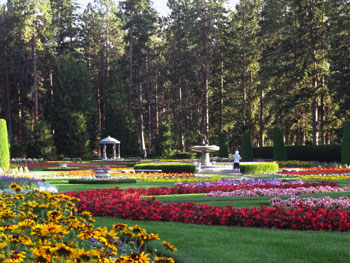 The park, designed by the famous Olmstead brothers of New York City’s Central Park fame, combines both the best of man’s landscaping ideas with Mother Nature’s unspoiled beauty. The area is prefaced by basalt rock formations jutting out everywhere. In the midst of the unspoiled habitat, my eyes were captivated by a stone bridge built in the 1930s. Even on a warm, sunny afternoon with the public out hiking, biking, or admiring one of the six gardens (including for lilacs and roses), I felt a real sense of calmness and peace in a place that once was a zoo, until the hard times of the Great Depression caused its closure. At the north central end of the park, one can still see remnants of the bear’s habitat, as just behind the Park Bench Café resides a basalt rock formation that has iron bars sticking out of it.
The park, designed by the famous Olmstead brothers of New York City’s Central Park fame, combines both the best of man’s landscaping ideas with Mother Nature’s unspoiled beauty. The area is prefaced by basalt rock formations jutting out everywhere. In the midst of the unspoiled habitat, my eyes were captivated by a stone bridge built in the 1930s. Even on a warm, sunny afternoon with the public out hiking, biking, or admiring one of the six gardens (including for lilacs and roses), I felt a real sense of calmness and peace in a place that once was a zoo, until the hard times of the Great Depression caused its closure. At the north central end of the park, one can still see remnants of the bear’s habitat, as just behind the Park Bench Café resides a basalt rock formation that has iron bars sticking out of it.
Of the six gardens, a must-see is the Duncan Garden, which was created in the spirit of European formal gardens in France and Italy centuries ago for royalty. Each year, some 70,000 annuals are planted there to make for a colorful scene of begonias, geraniums, marigolds, etc., that serve up those special backdrops for senior pictures and weddings.
Getting up close and personal with Browne’s Addition properties
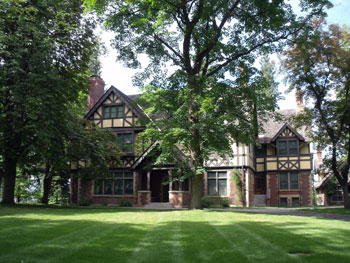 Tree-lined avenues to walk on are especially welcome during a balmy morning, which the Browne’s Addition provided for me. About a five-minute drive west of downtown, it was established in 1883, making it one of Washington State’s oldest neighborhoods whose homes include a mix of small and large dwellings and an array of 1970s and 1980s apartment complexes.
Tree-lined avenues to walk on are especially welcome during a balmy morning, which the Browne’s Addition provided for me. About a five-minute drive west of downtown, it was established in 1883, making it one of Washington State’s oldest neighborhoods whose homes include a mix of small and large dwellings and an array of 1970s and 1980s apartment complexes.
A number of the city’s early leading citizens have lived here, like mining baron Amasa B. Campbell, whose Georgian Tudor Style Revival home is now part of the Northwest Museum of Arts & Culture, both on W. 1st Ave.
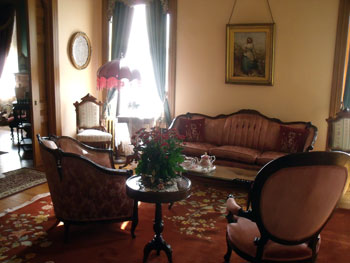 The spacious Campbell House, one of the inspired designs of architect Kirtland Cutter, offers tours. On the first and second floor, I got to view the family’s living quarters and Campbell’s personal office space. Guests get to see what life was life for the servants, who worked primarily in the basement. Here, 19th century lighting has been recreated (using old Thomas Edison reproduction light bulbs) to show how little light Campbell’s staff had while doing the laundry and other chores, which explains why there are windows in the basement for extra lighting. The property’s carriage house has plenty of exhibits that go over the history of the family and the late 19th and early 20th century times in Spokane. As big and dated as the house is, there’s been no reported haunting, even though it’s a bit creepy to explore. I took lots of pictures, and found no traces of orbs or ghosts.
The spacious Campbell House, one of the inspired designs of architect Kirtland Cutter, offers tours. On the first and second floor, I got to view the family’s living quarters and Campbell’s personal office space. Guests get to see what life was life for the servants, who worked primarily in the basement. Here, 19th century lighting has been recreated (using old Thomas Edison reproduction light bulbs) to show how little light Campbell’s staff had while doing the laundry and other chores, which explains why there are windows in the basement for extra lighting. The property’s carriage house has plenty of exhibits that go over the history of the family and the late 19th and early 20th century times in Spokane. As big and dated as the house is, there’s been no reported haunting, even though it’s a bit creepy to explore. I took lots of pictures, and found no traces of orbs or ghosts.
Just a couple of blocks south on 2nd Ave., is Coeur d’Alene Park, where a unique dating ritual took place in the early 20th century. Single women would make box lunches to be bid on by the eligible bachelors in the area. It still contains an old-fashioned bandstand that made me feel like I’d gone back over a hundred years in time.
 I took another tour of another famous Browne’s Addition house, The Roberts Mansion, also located on 1st Ave. It’s an 1889 Queen Anne Victorian home that serves as a bed and breakfast. The interior has been restored to reflect earlier times, but does offer guests the creature comforts of internet access and plasma TVs. I found the most notable aspect of the property in its backyard. It contains a “Secret Garden,” which is easily missed by guests because large shrubs obscure it, but once inside, it offered me a peaceful setting to rest in while surrounded by trees and other plant life. No wonder this place is used to host intimate gatherings.
I took another tour of another famous Browne’s Addition house, The Roberts Mansion, also located on 1st Ave. It’s an 1889 Queen Anne Victorian home that serves as a bed and breakfast. The interior has been restored to reflect earlier times, but does offer guests the creature comforts of internet access and plasma TVs. I found the most notable aspect of the property in its backyard. It contains a “Secret Garden,” which is easily missed by guests because large shrubs obscure it, but once inside, it offered me a peaceful setting to rest in while surrounded by trees and other plant life. No wonder this place is used to host intimate gatherings.
The Northwest Museum has produced a walking tour of Browne’s Addition downloadable on a computer or mobile device. See its website (listed below) for details.
Seeking windmills and a good deal in the South Perry District
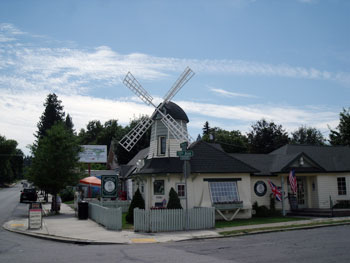 Dating back to the late 1800s, the South Perry District offered me a more rugged and vibrant city experience than the historic tranquility of the above two neighborhoods. It has blue collar roots, for its first businesses included a couple of lumberyards and a butcher shop. The most conspicuous landmark is located on the main drag of South Perry Street. It’s a Dutch windmill that originally housed a bakery, but has since had many businesses in it. Currently, there’s a health food and herbal store there, where I got some real black licorice made out of licorice root extract.
Dating back to the late 1800s, the South Perry District offered me a more rugged and vibrant city experience than the historic tranquility of the above two neighborhoods. It has blue collar roots, for its first businesses included a couple of lumberyards and a butcher shop. The most conspicuous landmark is located on the main drag of South Perry Street. It’s a Dutch windmill that originally housed a bakery, but has since had many businesses in it. Currently, there’s a health food and herbal store there, where I got some real black licorice made out of licorice root extract.
A block south, I sought out a good deal at the Windfall Thrift Store, trying to find a t-shirt with the words “Spokane” on it, and lo and behold, I found one for just a quarter. For a light lunch, we shared a tasty Shrimp Po’boy sandwich at Casper Fry, which specializes in pub-style grub. It offers patio dining under an umbrella, which we took advantage of, given the perfect summer afternoon. Lunch and dinner are served, and only closes when customers quit showing up.
As we explored the residential areas off the main drag of South Perry St., we came across a mix of old Craftsman and bungalow homes full of lush greenery, from maple, pine, and willow trees to green grapes growing just off the sidewalks of several homes.
Dining recommendation
My craving for a “healthier” option of pizza was more than satisfied even though I had to venture north of downtown to The Flying Goat. The place uses a 2500-pound Woodstone oven to make pizzas in a few minutes. There are around 15 different pizzas on the menu, but you can ask for a special order like I did. My pizza contained just a “fire-kissed” crust, sauce, olive oil, and some vegetables but was very tasty, especially cold. The place serves up some unique appetizers, salads, sandwiches, and brews. I must I admit I couldn’t eat just one…two…three…twenty-five of its homemade “A” Street Chips straight from the fryer.
If You Go:
♦ Manito Park
♦ Northwest Museum of Arts & Culture
♦ The Roberts Mansion
♦ Windfall Thrift Store
♦ Casper Fry
♦ The Flying Goat
♦ Spokane tourist information
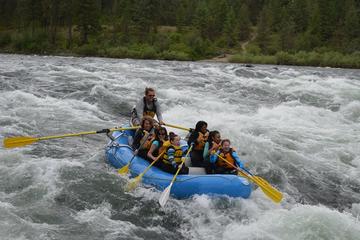
Scenic Rafting on the Spokane River
About the author:
Roy is a frequent contributor to Travel Thru History, and writes from southeastern Wyoming. Disclosure: The author attended a press trip sponsored by Visit Spokane, but what he wrote are his own observations, without any vetting by the sponsor.
All photos by Roy A. Barnes, and may not be used without permission.

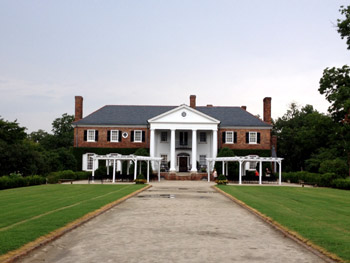




 As I walked through the downtown area, I couldn’t help but notice just how much brick, stone, and terra cotta dominated the exteriors of the buildings. This came about after the fire in 1889, which destroyed 32 blocks. One of the city’s landmarks, Steam Plant Square, once provided much of the steam heat and electrical power for the city from 1916-1986, then it would remained neglected for ten years. To make a long story short, the building has been restored with some of its original infrastructure in tact that helps make the existing businesses and offices a unique place to explore or work in.
As I walked through the downtown area, I couldn’t help but notice just how much brick, stone, and terra cotta dominated the exteriors of the buildings. This came about after the fire in 1889, which destroyed 32 blocks. One of the city’s landmarks, Steam Plant Square, once provided much of the steam heat and electrical power for the city from 1916-1986, then it would remained neglected for ten years. To make a long story short, the building has been restored with some of its original infrastructure in tact that helps make the existing businesses and offices a unique place to explore or work in. But I also savored some great-tasting beer and fish inside the landmark at the Stacks at Steam Plant. It has an intimate atmosphere dominated by an industrial brown and black motif. I dined amidst the factory’s old fixtures. The restaurant features a full menu of seafood, beef, chicken, and pasta dishes and brews its own beer, including one uniquely-flavored and really smooth tasting Double Stack Stout, which contains chocolate, vanilla, and espresso. I highly recommend the Smoked Steelhead, which has a taste to die for, as the fish was smoked over alder wood and brined in the restaurant’s Highland and Scottish ale and spices.
But I also savored some great-tasting beer and fish inside the landmark at the Stacks at Steam Plant. It has an intimate atmosphere dominated by an industrial brown and black motif. I dined amidst the factory’s old fixtures. The restaurant features a full menu of seafood, beef, chicken, and pasta dishes and brews its own beer, including one uniquely-flavored and really smooth tasting Double Stack Stout, which contains chocolate, vanilla, and espresso. I highly recommend the Smoked Steelhead, which has a taste to die for, as the fish was smoked over alder wood and brined in the restaurant’s Highland and Scottish ale and spices. As a travel writer, a hotel is generally the first and last place I visit during a stay in a city. I’m more concerned about its functionality than anything else. Yet I couldn’t appreciate Spokane’s history without appreciating the history of a hotel that helped put Spokane on the map, The Davenport Hotel.
As a travel writer, a hotel is generally the first and last place I visit during a stay in a city. I’m more concerned about its functionality than anything else. Yet I couldn’t appreciate Spokane’s history without appreciating the history of a hotel that helped put Spokane on the map, The Davenport Hotel.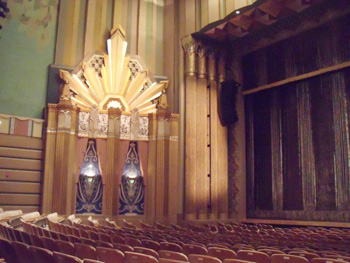 I’m impressed with Art Deco design, and in the heart of downtown an old movie house that originally showed 20th Century Fox pictures has become one of the city’s cultural meccas. The Martin Woldson Theater at the Fox was first opened in 1931, and what drew people there weren’t only the feature films, but the fact that it got to be the first place in town to get air conditioning, a must-see for Spokane’s curious locals. After it was closed down in 2000 during its bargain-movie-showing period, the long road to restoring it to its Art Deco glory would begin. Seven years and $31 million later, the dream came to pass. I was especially impressed with the auditorium, which holds 1,620-1,720 people and has green and pink stripes on the walls. The lobby exudes tropical designs on blue and gold walls. It took considerable time to remove the thick layers of red paint that dominated those days of cheap second-run flicks.
I’m impressed with Art Deco design, and in the heart of downtown an old movie house that originally showed 20th Century Fox pictures has become one of the city’s cultural meccas. The Martin Woldson Theater at the Fox was first opened in 1931, and what drew people there weren’t only the feature films, but the fact that it got to be the first place in town to get air conditioning, a must-see for Spokane’s curious locals. After it was closed down in 2000 during its bargain-movie-showing period, the long road to restoring it to its Art Deco glory would begin. Seven years and $31 million later, the dream came to pass. I was especially impressed with the auditorium, which holds 1,620-1,720 people and has green and pink stripes on the walls. The lobby exudes tropical designs on blue and gold walls. It took considerable time to remove the thick layers of red paint that dominated those days of cheap second-run flicks.
 The High Line was set to be demolished around 1999 when a couple of New Yorkers started a movement to not only save the structure, but make it an extraordinary space for park goers to enjoy. The High Line is perfect for an early evening stroll when the Big Apple starts to cool down on a hot summer’s day. It’s free and although uncomfortably crowded in spots, you can’t beat enjoying the ever-changing streetscapes and unexpected scenery at your feet.
The High Line was set to be demolished around 1999 when a couple of New Yorkers started a movement to not only save the structure, but make it an extraordinary space for park goers to enjoy. The High Line is perfect for an early evening stroll when the Big Apple starts to cool down on a hot summer’s day. It’s free and although uncomfortably crowded in spots, you can’t beat enjoying the ever-changing streetscapes and unexpected scenery at your feet.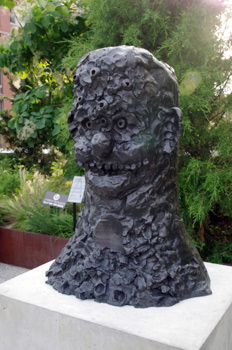 My travelling companions and I started the High Line near its northern terminus on West 30th Street between 10th and 11th avenues. Signage was not great and we got on the High Line by climbing a metal staircase only to find that there was an elevator nearby.
My travelling companions and I started the High Line near its northern terminus on West 30th Street between 10th and 11th avenues. Signage was not great and we got on the High Line by climbing a metal staircase only to find that there was an elevator nearby.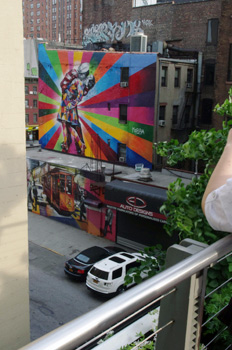 The walking path itself narrows to several people wide and expands to triple that in places with seating when it is most unexpected and appreciated. This includes a place called the 10th Avenue Square, complete with bleachers and huge picture windows for a broad view of the street life.
The walking path itself narrows to several people wide and expands to triple that in places with seating when it is most unexpected and appreciated. This includes a place called the 10th Avenue Square, complete with bleachers and huge picture windows for a broad view of the street life.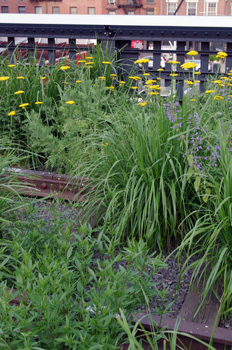 Sections of rusted track can be spotted throughout the High Line, but they are not always easy to find. This caused our group of park goers to each try to be the first to find a piece of old rail line at every change in garden space. The searches bordered on the obsessive by the end of our walk. Sometimes the old rails were far from the walking path and shaded by lush plants, growing among the rail ties like weeds did in the 1980s.
Sections of rusted track can be spotted throughout the High Line, but they are not always easy to find. This caused our group of park goers to each try to be the first to find a piece of old rail line at every change in garden space. The searches bordered on the obsessive by the end of our walk. Sometimes the old rails were far from the walking path and shaded by lush plants, growing among the rail ties like weeds did in the 1980s.
 The High Line’s scale is more manageable than upper Manhattan’s huge Central Park. The two share a quirky characteristic in how the old concrete jungles appear to butt up against the green space of the parks for abrupt visual contrasts.
The High Line’s scale is more manageable than upper Manhattan’s huge Central Park. The two share a quirky characteristic in how the old concrete jungles appear to butt up against the green space of the parks for abrupt visual contrasts.

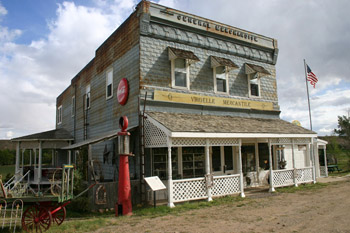
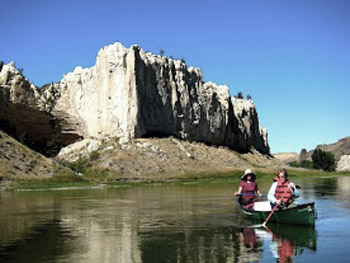 Rather than the tame goings-on of the last couple of centuries, it’s the little-known facts about Lewis and Clark and their expedition through un-mapped Missouri River wilderness which guide Mike Nottingham loves to discuss. This mountain man, trapper, fisherman, and river guide for the Missouri River Canoe Company even teaches you how to pronounce Sacagawea’s name correctly.
Rather than the tame goings-on of the last couple of centuries, it’s the little-known facts about Lewis and Clark and their expedition through un-mapped Missouri River wilderness which guide Mike Nottingham loves to discuss. This mountain man, trapper, fisherman, and river guide for the Missouri River Canoe Company even teaches you how to pronounce Sacagawea’s name correctly. I went one step further. I chose the sheep wagon. How could I resist? It looked like one of the coolest places I would ever sleep. And it was. All night I heard coyotes howling in the distance as the light of the half moon glimmered through my canvas-topped covered wagon. I felt like Laura Ingalls.
I went one step further. I chose the sheep wagon. How could I resist? It looked like one of the coolest places I would ever sleep. And it was. All night I heard coyotes howling in the distance as the light of the half moon glimmered through my canvas-topped covered wagon. I felt like Laura Ingalls. From our canoes, we didn’t see another soul on the river or bank, not a house, not even a broken-down homesteader’s shack. In fact, the Missouri Breaks landscape today, thanks to stewardship and land management, looks pretty much the way it would have looked to Lewis and Clark, even more so now than in the brief late-19th century steamboat days when trees were felled to fuel the boats. “The only difference now,” said Nottingham, “are the occasional Russian olive trees along the banks, which are invasive.” There’s also the odd cow which comes down from one of the ranches for a drink. Back then, of course, it would have been buffalo.
From our canoes, we didn’t see another soul on the river or bank, not a house, not even a broken-down homesteader’s shack. In fact, the Missouri Breaks landscape today, thanks to stewardship and land management, looks pretty much the way it would have looked to Lewis and Clark, even more so now than in the brief late-19th century steamboat days when trees were felled to fuel the boats. “The only difference now,” said Nottingham, “are the occasional Russian olive trees along the banks, which are invasive.” There’s also the odd cow which comes down from one of the ranches for a drink. Back then, of course, it would have been buffalo.

